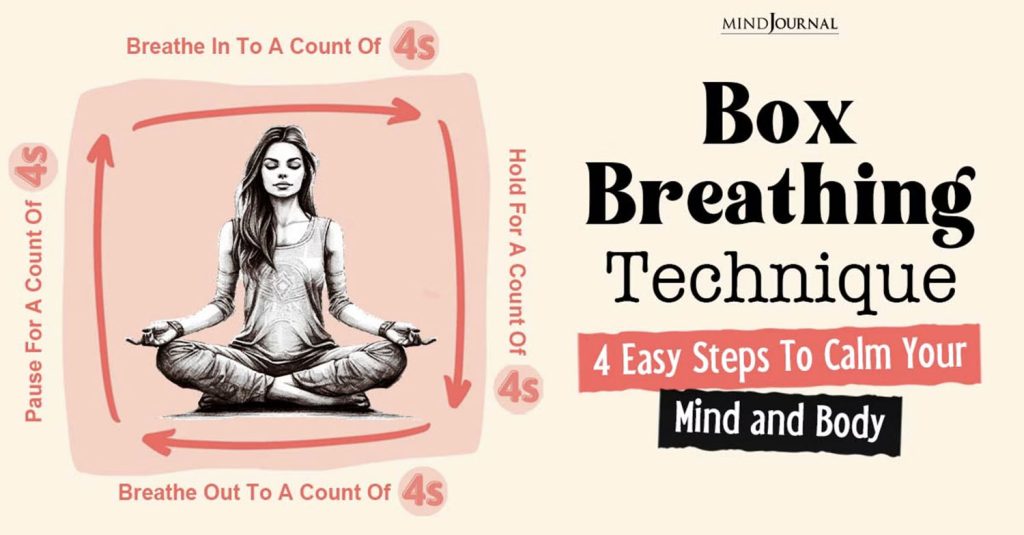
By Alliance Communications Coordinator Amy Durr
It feels like I was born with an extra dose of anxiety, and since I arrived 6 weeks early maybe it’s true. I’ve spent much of my adult life on a quest to reduce it. The results have been comically broad, but a few techniques really stand out, including box breathing.
What is Box Breathing?
“Box breathing is a simple breathing technique that brings profound benefits. In fact, even the US Navy SEALs, some of the world’s toughest soldiers, use it in high-stress situations. Also known as square breathing or four-square breathing…box breathing is known for improving physiological responses, helping to calm the mind, and bringing focus,” according to Calm.
A recent study on box breathing with adolescents showed: “Participants also reported greater success at emotion regulation following the breathing compared to the control condition. Therefore, slow-paced breathing may be an effective tool to acutely enhance emotion regulation abilities, possibly through the increase in parasympathetic nervous system activation.”
Just 3 minutes of box breathing affects emotional regulation in a positive way:
- A significant reduction in negative emotional responses
- Greater mental flexibility, especially around negative feelings
- An increased ability to change their perspective more easily
A breathing practice, even for 10 minutes a day or less, has amazing positive effects on your physiology and psychology, according to the same study.
I Will Latch on to Anything that Might Soothe My Brain
Many years ago I read an article in a travel magazine titled something like, “How to Survive a Disaster.” I only remember two points:
- Always listen to the pre-flight instructions and review the card for the nearest exit, and the second nearest one. Basically, know how to get out of the plane.
- Box breathe if you are in a stressful situation. You want to be relaxed enough to come up with solutions and make rational decisions. In other words, calmness is necessary for problem solving, especially in emergencies.
That day I started box breathing and I’ve never stopped, with further encouragement from my therapist. I’ve breathed through terrifying doctor appointments, being lost and alone in countries where I don’t speak the language and facing my cats’ wrath. I’ve almost put myself to sleep on the OBGYN exam table.
How to Box Breathe
Learning to box breathe is simple, but you will get better results with practice. In fact, with time you become sort of Pavlovian – with the first couple of breaths you are steadied. I box breathe for practice whenever I feel a little tense. Dentist offices, traffic jams, presenting at Career Day to a class third graders – any slightly uncomfortable place you find yourself.
As Calm describes:
“Box breathing is as simple and accessible as it is powerful. Whether at home, the office, or taking the train to work, this technique can help you to feel more relaxed and grounded during stressful situations.
- Find a quiet space: Choose a spot where you can sit or lie comfortably in a relatively quiet environment.
- Close your eyes: It’s not essential, but closing your eyes can help you focus on yourself.
- Inhale for four seconds: Breathe in deeply, feeling your lungs fill up, counting to four slowly. Imagine you’re drawing energy into your body.
- Hold that breath: Hold that breath in for another four seconds. It might feel strange at first, but it’ll feel more natural with practice.
- Exhale slowly: Exhale for four seconds, releasing the air steadily. Imagine all your stresses and worries leaving your body as you breathe.
- Hold again: Hold for another four seconds. This pause signals to your body that another ‘box’ or cycle is about to begin.
Box breathing offers a predictable rhythm in a world that’s often unpredictable. It gives a beat that your mind and body can move to, bringing you harmony and peace. Start practicing for a few minutes, gradually increasing as you become more comfortable.
A four-second count isn’t set in stone—if you prefer, try three or five seconds. The key is to keep each segment equal.”
Breathing Techniques Work for Everyone, Including Kids
What can we do during calm moments to strengthen our kids’ emotional toolkit and build resilience? “The most foundational technique is deep breathing,” says PBS Kids. “When we are stressed or upset, our heart rate increases and our breath becomes more rapid and shallow. We enter fight or flight mode. And all parents know that it’s almost impossible to reason with kids when they are in this mode!”
PBS Kids continues, “But when we take deep breaths, we send a message back to the brain: It’s okay to settle down. Mindful breathing can calm the storm a little faster.”
More than Just Emotional Regulation: The Benefits
Box breathing is designed to give a rhythmic, even pattern to breathing. According to Calm, it’s been linked to numerous health benefits including:
- Stress reduction and anxiety management: When everything feels overwhelming, box breathing can act as an anchor. Focusing on your breath and rhythm gives your brain a break from the chaos, reducing feelings of anxiety and stress.
- Improved focus and concentration: Concentrating your thoughts on your breath moves your attention away from distractions, training your mind to concentrate. Consistent practice can improve your ability to focus on everyday tasks.
- Lowered heart rate and blood pressure: Chronic stress can cause problems with your heart health. Box breathing can help regulate and lower your heart rate, reducing blood pressure.
- Enhanced relaxation and sleep quality: Struggling with insomnia? Box breathing can help calm your mind and body, preparing you for a restful sleep.
- Emotional balance: Through regular practice, box breathing offers a grounding effect for your emotions. This means your reactions are likely to become more measured, promoting balance and emotional wellbeing.
Box breathing isn’t just about taking in oxygen and releasing carbon dioxide. It’s a simple mindfulness technique that can help to calm you mentally while also supporting your physical health.
I’ve shared box breathing with many people, and others have shared it with me – doctors, psychologists, authors and EMTs. So the next time your cat eyes you up and then deliberately walks across your keyboard in the middle of an important Zoom meeting, imagine a square and start breathing.


